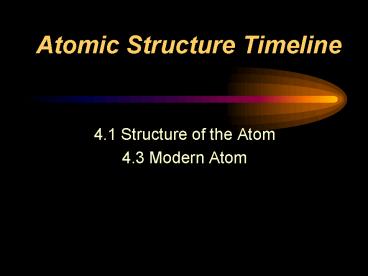Atomic Structure Timeline - PowerPoint PPT Presentation
1 / 14
Title:
Atomic Structure Timeline
Description:
Proposed that matter was composed of tiny indivisible particles ... Gold Foil Experiment. Discovered the nucleus. dense, positive charge in the center of the atom ... – PowerPoint PPT presentation
Number of Views:4668
Avg rating:3.0/5.0
Title: Atomic Structure Timeline
1
Atomic Structure Timeline
- 4.1 Structure of the Atom
- 4.3 Modern Atom
2
Democritus (400 B.C.)
- Proposed that matter was composed of tiny
indivisible particles - Believed atoms properties were based on shape
- Greek atomos (indivisible)
- Opposed by Aristotle who believed matter was
infinite
3
John Dalton (1807)
- British Schoolteacher
- based his theory on experimental data
- Billiard Ball Model
- atom is a uniform, solid sphere
4
John Dalton
Daltons Theory
1. All elements are made of atoms. 2. Atoms of
the same element have the same mass. Atoms of
different elements have different
masses. 3. Compounds contain atoms of more than
one element. 4. In a particular compound, atoms
of different elements always combine in the same
way.
5
J. J. Thomson (1903)
- Cathode Ray Tube Experiments
- beam of negative particles
- Discovered Electrons
- negative particles within the atom
- Plum-pudding Model
6
J. J. Thomson (1903)
- Plum-pudding Model (a.k.a. Chocolate chip ice
cream) - positive sphere (pudding) with negative
electrons (plums) dispersed throughout
7
Ernest Rutherford (1911)
- Gold Foil Experiment
- Discovered the nucleus
- dense, positive charge in the center of the atom
- Nuclear Model
8
Ernest Rutherford (1911)
- Nuclear Model
- dense, positive nucleus surrounded by negative
electrons
9
Niels Bohr (1913)
- Bright-Line Spectrum
- tried to explain presence of specific colors in
hydrogens spectrum - Energy Levels
- electrons can only exist in specific energy
states - Planetary Model
10
Niels Bohr (1913)
Bright-line spectrum
- Planetary Model
- electrons move in circular orbits within specific
energy levels
11
Erwin Schrödinger (1926)
- Quantum mechanics
- electrons can only exist in specified energy
states - Electron cloud model
- orbital region around the nucleus where e- are
likely to be found
12
Erwin Schrödinger (1926)
- Electron Cloud Model (orbital)
- dots represent probability of finding an e- not
actual electrons
13
James Chadwick (1932)
- Discovered neutrons
- neutral particles in the nucleus of an atom
- Joliot-Curie Experiments
- based his theory on their experimental evidence
14
James Chadwick (1932)
- Neutron Model
- revision of Rutherfords Nuclear Model































